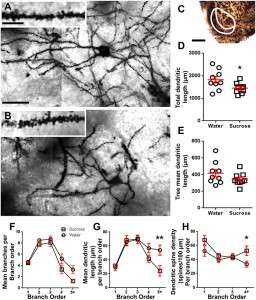Sugar—the addictive enemy hiding in plain sight

Could you image a world without sugar? A life without that spectacular sweet taste in your mouth?
Sugar is something that we consume constantly as it is everywhere. Several reports estimate that up to 75% of all foods and beverages contain high amounts of added sugars (Ford and Dietz, 2013; Bray and Popkin, 2014). In fact, excess sugar consumption is implicated as one of the essential and underlying components of the current obesity epidemic, which has now become a worldwide problem.
It is nowadays well established that sugar can exert an extremely powerful impact on the brain reward system, the same system that tells us what we like and what we dislike. Interestingly, sugar may trigger the same dopamine-mediated biological mechanisms that recreational drugs such as cocaine, amphetamines, morphine and nicotine do. Upon an increase in the levels of dopamine, the reward's mediator, we are confronted with cravings. Moreover, animal studies have clearly shown that long-term consumption of palatable foods can cause changes in the brain reward pathways, which suggests an imbalance in the normal reward processing homeostasis. But how exactly does sugar affect the brain? Here, Dr. Nicole Avena tries giving her answer, suggesting that an overload of sugar spikes dopamine levels and leaves you craving more and more. From this point of view, shared by many neuroscientists, one could legitimately start wondering whether sugar addiction may be treated as any other drug addiction.
A recent study published in PLOS ONE by Shariff and colleagues demonstrates that sugar addiction and nicotine dependency may share some common biochemical substrates. In particular, a common mechanism may take place at the level of the neuronal nicotinic acetylcholine receptors (nAChRs). In fact, the authors of the study observed that Varenicline, a partial agonist of nAChRs able to reduce nicotine cravings and withdrawal symptoms, was also able to efficiently reduce sugar consumption in rats.
Using an intermittent-access two-bottle choice test, Shariff and colleagues report that Varenicline strongly reduced sugar intake, thus breaking down the need for sugar consumption. Indeed, such "therapeutic" effects on sugar craving were also observed when another nAChRs ligand was used, thus suggesting that nicotine and sugar share common pathways. In addition to these pharmacological experiments, the authors of the current study also found that long-term sucrose exposure results in an increase in the expression of nAChR receptor subunits in the nucleus accumbens (NAc), a brain region known to be highly involved in the rewarding properties of addictive substances.
"Excess sugar consumption has been proven to contribute directly to weight gain. It has also been shown to repeatedly elevate dopamine levels which control the brain's reward and pleasure centers in a way that is similar to many drugs of abuse including tobacco, cocaine and morphine" says Pr. Selena Bartlett, neuroscientist at the Queensland University of Technology (QUT) and senior author of the study. "We have also found" continues Bartlett, "that as well as an increased risk of weight gain, animals that maintain high sugar consumption and binge eating into adulthood may also face neurological and psychiatric consequences affecting mood and motivation."
Interestingly, the same team has also recently published another report showing the effect of long-term sugar consumption on the morphology of accumbal neurons, also known as medium-sized spiny neurons (MSNs) (Klenowski et al., 2016). Klenowski and colleagues showed that prolonged binge-like sucrose consumption significantly decreased the total dendritic length of MSNs compared to age-matched control rats. In addition, they found that the restructuring of these neurons resulted primarily from reduced distal dendritic complexity.
Conversely, "increased spine densities at the distal branch orders of Nac shell MSNs from long-term sucrose consuming rats" were observed. Altogether, these data strongly suggest that sugar addiction may be able to alter behavioral responses (cravings) as well as to induce specific morphological adaptations.
These observations, combined with studies demonstrating the contribution of excessive sugar intake to changes in reward circuitry and the development of addictive-like behaviors and emotional states in animal models (Avena et al., 2008; Benton, 2010; Ventura et al., 2014), warrant the need for further investigation. Astonishingly, the team of Serge Ahmed has shown that intense sweetness can surpass cocaine reward, even in drug-sensitized and -addicted individuals (Lenoir et al., 2007). Could sugar be the worst legal drug? Could sugar be the most abused drug? These and other studies all strongly point to one simple conclusion: sugar, especially when abused, can be extremely dangerous. Therefore, action in the form of social change, such as taxation of junk food and sugar sweetened beverages (Cornelsen and Carriedo, 2015), as well as educational interventions on nutrition and food consumption, is urgent for the wellbeing of our society.
More information: Masroor Shariff et al. Neuronal Nicotinic Acetylcholine Receptor Modulators Reduce Sugar Intake, PLOS ONE (2016). DOI: 10.1371/journal.pone.0150270
E. S. Ford et al. Trends in energy intake among adults in the United States: findings from NHANES, American Journal of Clinical Nutrition (2013). DOI: 10.3945/ajcn.112.052662
G. A. Bray et al. Dietary Sugar and Body Weight: Have We Reached a Crisis in the Epidemic of Obesity and Diabetes?: Health Be Damned! Pour on the Sugar, Diabetes Care (2014). DOI: 10.2337/dc13-2085
Masroor Shariff et al. Neuronal Nicotinic Acetylcholine Receptor Modulators Reduce Sugar Intake, PLOS ONE (2016). DOI: 10.1371/journal.pone.0150270
Paul M. Klenowski et al. Prolonged Consumption of Sucrose in a Binge-Like Manner, Alters the Morphology of Medium Spiny Neurons in the Nucleus Accumbens Shell, Frontiers in Behavioral Neuroscience (2016). DOI: 10.3389/fnbeh.2016.00054
Nicole M. Avena et al. Evidence for sugar addiction: Behavioral and neurochemical effects of intermittent, excessive sugar intake, Neuroscience & Biobehavioral Reviews (2008). DOI: 10.1016/j.neubiorev.2007.04.019
David Benton. The plausibility of sugar addiction and its role in obesity and eating disorders, Clinical Nutrition (2010). DOI: 10.1016/j.clnu.2009.12.001
Tamara Ventura et al. Neurobiologic basis of craving for carbohydrates, Nutrition (2014). DOI: 10.1016/j.nut.2013.06.010 Magalie Lenoir et al. Intense Sweetness Surpasses Cocaine Reward, PLoS ONE (2007). DOI: 10.1371/journal.pone.0000698
This story is republished courtesy of PLOS Blogs: blogs.plos.org.
















